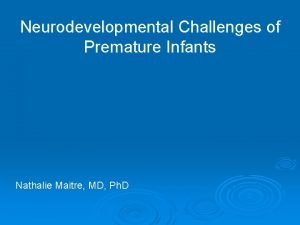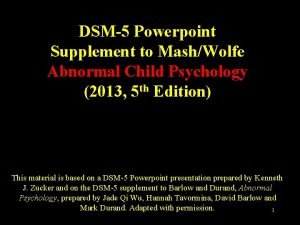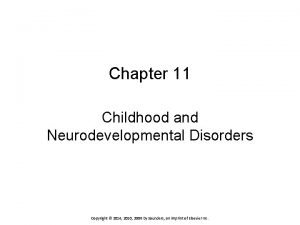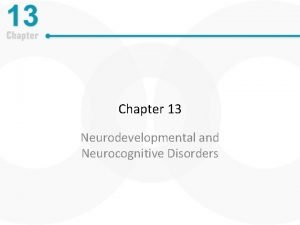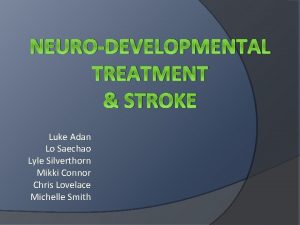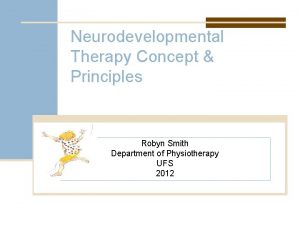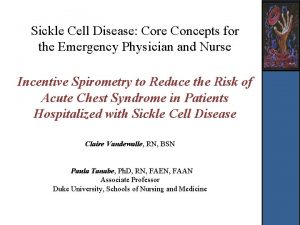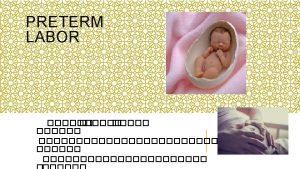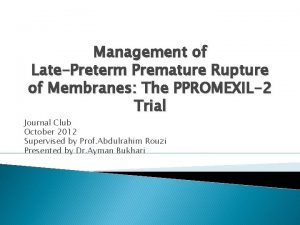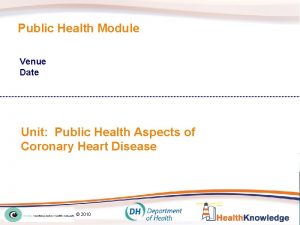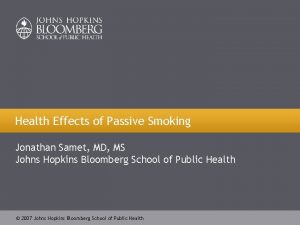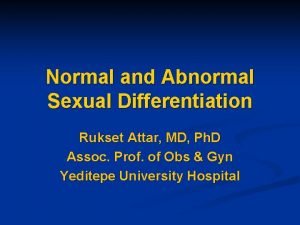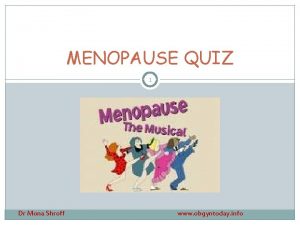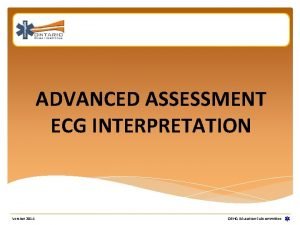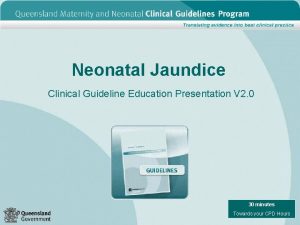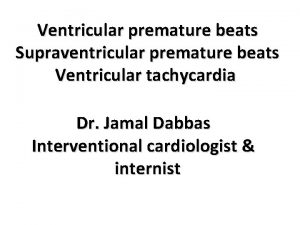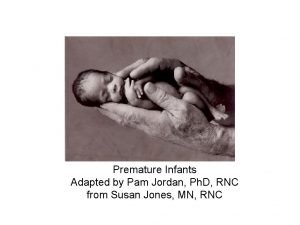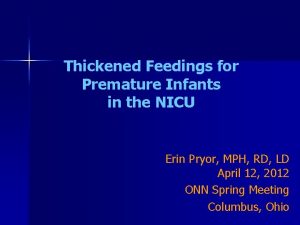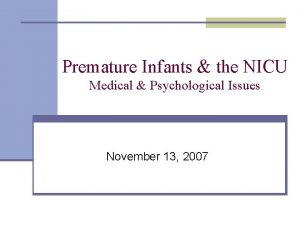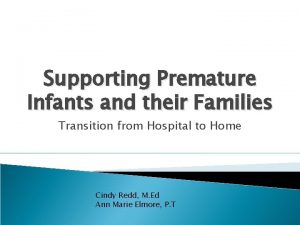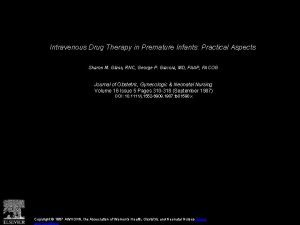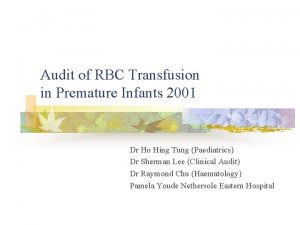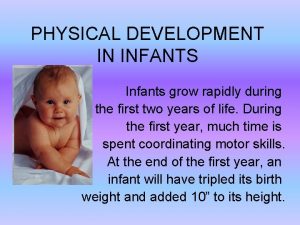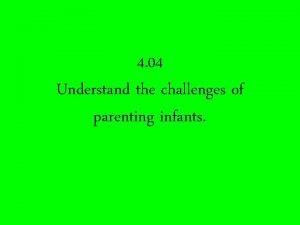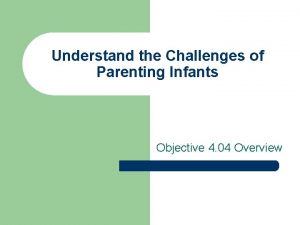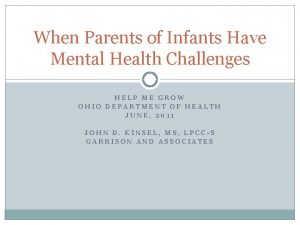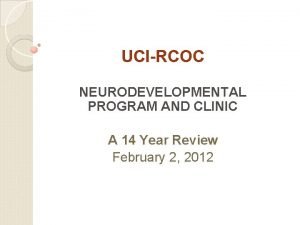Neurodevelopmental Challenges of Premature Infants Nathalie Maitre MD








































- Slides: 40

Neurodevelopmental Challenges of Premature Infants Nathalie Maitre, MD, Ph. D

Goals Ø Identify factors in the intensive care nursery which influence the development of premature infants. Ø Understand the prevalence of various neurodevelopmental impairments of premature infants. Ø Review selected therapies with evidence for effect in premature infants.

Goal 1 Ø Identify factors in the intensive care nursery which influence the development of premature infants.

Pathogenesis of Impairment in Premature Infants Immature Neural Development NICU environment MICU Course Interventions Complications Cognitive Impairment Perinatal Injury Remodeling of Neural Pathways Neurosensory Impairment Motor Impairment Executive Dysfunction

In the Beginning

Insults to CNS development Ø Maternal infections Ø IVH/PVL Ø Hypoxic ischemic encephalopathy Ø Reperfusion Ø Excitotoxicity, oxidative stress, inflammation Ø Inherited deficits Ø Medications

The NICU environment

Ventilators Ø Neurodevelopmental outcomes worsen the longer an infant is on a ventilator Ø Oral/sensory consequences Ø Physical consequences Ø CLD and long-term function

Touch Effect of immature system on perception of touch Ø Perception of pain Ø Efficacy of pain management Ø Lasting effects Ø

Sound Ø Average sound background in NICUs Ø Sound toxicity Light Ø Circadian rhythms affect the HPA axis Ø Darkness vs. cycled light Ø Phototherapy

Positive influences in the NICU

Developmental Care • NIDCAP • Stimulation interventions • decrease hospitalization duration • some studies of long-term effects • many show positive short term effects

Kangaroo Care Positive effects on growth, sleep, feeding and stress levels

Summary Ø Premature infants are at high risk for perinatal insults to the CNS. Ø The intensive care environment contributes to the altered development of the premature brain. Ø Few interventions in the intensive care nursery are positive input to the developing nervous system.

Goal 2 Ø Understand the prevalence of various neurodevelopmental impairments of premature infants

The more premature the infant, the more likely there will be an adverse outcome.

Adverse outcomes: l Low incidence - High severity l High incidence – Low severity

What is a severe disability? Extreme variation in definitions Ø Severe: combinations of MDI<70 or 50, PDI <70 or 50, IQ <70, CP, neurosensory deficit. Ø Can’t run, wash hands or make a 3 word sentence at the age of 3 years. Ø

Severe disability

Major Disabilities Based Upon Birth Weight

Cognitive Abilities “ The mental faculty of knowing, which includes perceiving, recognizing, conceiving, judging, reasoning, and imagining. ” The American Heritage® Medical Dictionary Copyright © 2007, 2004 by Houghton Mifflin Company.

Cognitive Impairment: IQ <70 Ø 9. 54 x greater in children who were born < 750 g Ø 2. 15 x greater in those 751 -1499 g Ø 10 points < sibling controls

Motor Difficulties Cerebral palsy The Definition and Classification of Cerebral Palsy (2007)Developmental Medicine & Child Neurology

Cerebral Palsy Ø Overall 40 -50% of children with CP were born prematurely. Ø The more premature the higher risk of CP. Ø Periventricular leukomalacia and severe grades of IVH increases the risk of CP.

High prevalence / low severity dysfunction Ø Learning disabilities (30 -60%) Ø Low average or borderline IQ (15 -40%) Ø ADHD (9 -10%) Ø Neuro-psychological deficits Ø Behavioral disorders

Executive function Ø Processes responsible for purposeful, goal directed behavior which impact on cognitive, emotional, behavioral and social functions Ø Normal IQ does not exclude executive dysfunction

Executive function in ELBW Anderson, Doyle 04 Ø significant dysfunction in metacognition and in behavioral regulation compared to NBW Ø NOT more impulsive

Speech Impairments Apraxia of speech Ø Speech delay Ø Feeding disorders Ø Stuttering Ø Language delay (receptive/expressive) Ø Articulation impairment Ø

Attention and Behavior Impairments Delobel, EPIPAGE 06

Sensory function Ø Visual l l Blindness Refractive errors Strabismus Nystagmus Hearing Ø Sensory integration Ø

Summary Ø Premature infants are at high risk for major and minor impairments. Ø The frequency and severity of impairments increases as gestational age decreases

Goal 3 Ø Review selected therapies with evidence for effect in premature infants

Interventions Modalities Ø Programs Ø Therapists Ø Equipment Ø Medications Ø Surgery Ø Educational support

Evidence-based therapies Ø Constraint induced movement therapy

Evidence-based therapies Ø Functional electrical stimulation or neuromuscular electrical stimulation

Evidence-based therapies Ø Body weight supported treadmill training

Interventions and assistive devices Ø Botox injections Ø Surgery Ø Orthotics, splints, walkers

Sensory integration therapy

Speech Therapy Feeding therapy Therapy for apraxia

Acknowledgements Ø At UNC Hospitals: Janice Wereszczak, Diane Marshall and the entire SICC team Ø At Duke University: Ricki Goldstein, Lylie Bonzani, Kara Lardinois
 Nathalie maitre
Nathalie maitre Neurodevelopmental disorders dsm-5 ppt
Neurodevelopmental disorders dsm-5 ppt Chapter 11 childhood and neurodevelopmental disorders
Chapter 11 childhood and neurodevelopmental disorders Mild neurocognitive disorder
Mild neurocognitive disorder Neurodevelopmental treatment for stroke
Neurodevelopmental treatment for stroke Neurodevelopmental disorders
Neurodevelopmental disorders Neurodevelopmental therapy principles
Neurodevelopmental therapy principles Premature death
Premature death Block nhĩ thất độ 2 mobitz 2
Block nhĩ thất độ 2 mobitz 2 70 on contraction monitor
70 on contraction monitor Tocolytic drugs
Tocolytic drugs Premature rupture of membranes management
Premature rupture of membranes management Premature death
Premature death Yarık damak dudak hemşirelik tanıları
Yarık damak dudak hemşirelik tanıları Premature adrenarche
Premature adrenarche Diagnosis of pprom
Diagnosis of pprom תסחיף מי שפיר
תסחיף מי שפיר Premature death
Premature death Tanner stages of breast development
Tanner stages of breast development Premature focus trap
Premature focus trap Why splenomegaly in hemolytic anemia
Why splenomegaly in hemolytic anemia Premature menopause quiz
Premature menopause quiz Paida therapy
Paida therapy Pjc rhythm
Pjc rhythm Types of jaundice pdf
Types of jaundice pdf Viens esprit de dieu fait nous sentir ta presence
Viens esprit de dieu fait nous sentir ta presence Equation d'activation et desactivation grafcet
Equation d'activation et desactivation grafcet Du maitre qui m'appelle
Du maitre qui m'appelle Travaillons tous pour notre maitre
Travaillons tous pour notre maitre Remercier un maitre de stage
Remercier un maitre de stage Stapédectomie définition
Stapédectomie définition 5 principes de gelman
5 principes de gelman La ficelle maupassant fiche de lecture
La ficelle maupassant fiche de lecture Travaillons tous pour notre maitre
Travaillons tous pour notre maitre Maitre gims hello sista
Maitre gims hello sista Je l'ai trouvé le bonheur ineffable
Je l'ai trouvé le bonheur ineffable Coumadin dosage
Coumadin dosage Nathalie curadeau
Nathalie curadeau Nathalie rauschmayr
Nathalie rauschmayr Charles aznavour natalie
Charles aznavour natalie Nathalie ng
Nathalie ng
